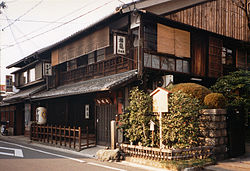
Sakamoto Ryōma
Share
Sakamoto Ryōma (Japanese: 坂本 龍馬, 1835-1867) was a low-ranking samurai who led the movement to overthrow the Tokugawa bakufu in pre-Meiji Restoration Japan. He also used the pseudonym Saitani Umetarō in his actions against the bakufu.
Sakamoto Ryōma Life
Early life
Sakamoto Ryōma was born in 1835 in Kōchi, Tōsa Province, in what is now Kōchi Prefecture. He was the fifth and youngest child of a lower-class provincial Samurai family (gōshi).
Ryōma started school in 1846, but dropped out after a short time. He had no interest in the study of literature and, as the youngest son in the family, had no obligation to do so, as defined by his status.
In 1848, Ryōma's family sent him to the Hineno Benji dōjō in Tosa to study kenjutsu. In 1853 he travelled to Edo, now Tokyo, to continue his studies of Hokushin ittō-ryūn swordsmanship under Chiba Sadakichi.
Matthew Perry arrived in Japan on 8 July 1853, and Ryōma participated in the coastal troops called together by the bakufu in Shinagawa. The young samurai served under the bakufu until Perry's departure in 1854.
After his release, Ryōma visited his native Tosa, but returned to Edo in 1856 for a year to continue his kenjutsu studies. While studying, Ryōma came into contact with the anti-foreigner sonnō jōi movement.
After returning to Tosa, Ryōma joined the Tosa kinnō party led by Takechi Zuizan in 1861, which advocated the expulsion of foreigners and the closure of Japan.
Eventually, however, Ryōma grew tired of Zuizan's failures and left Tosa without permission on 22 April 1862. As a result of his departure, he became an outlaw and masterless samurai or rōnin.
Sakamoto Ryōma The masterless samurai

Rōninina Ryōma decided to assassinate the high-ranking official Katsu Kaishū. Kaishū was in favour of opening Japan to the world, and had often dealt with foreigners. Kaishū had studied in Nagasaki under the Dutch and visited the United States with the Japanese embassy.
Matsudaira Shungaku arranged for Ryōma to receive a letter of recommendation, which offered him the opportunity to meet Kaishū. Ryōma did meet Kaishū but did not carry out his assassination attempt, as Kaishū managed to talk Ryōma out of it. He became Kaishū's disciple.
Ryōma helped Kaishū to establish the Hyōgo Naval School in Kōbee, including acting as a recruiter for new students. He succeeded in bringing several young samurai to Kaishū, especially from the Tosa region.
Through Kaishū, Ryōma became more familiar with the sea and with the West and the technology they had developed. Kaishūn was able to use his position to keep the bakufu authorities out of the clutches of Ryōma, who had abandoned his han, but in this regard his support ended on 10 November 1864 when the bakufu dismissed Kaishūn.
As a result, Ryōma sought refuge in the Satsuma region opposite Tokugawa.
Under Satsuma's protection, Ryōma established a company, initially known as Shachū. The name was changed to Kaienta in 1867, and the company became Japan's first modern corporation.
Based in Nagasaki, the company's activities focused on shipping and transporting goods. Through Shachū, Ryōma transported Western weapons to the anti-Satsuma and anti-Chōshū Bakufu forces.
He later succeeded in negotiating an alliance between long-time enemies Satsuma and Chōshū in 1866.
Teradaya incident

While in Kyoto, Ryōma spent a lot of time at the Teradaya inn, a favourite of the Satsuma samurai. He also visited the inn immediately after the successful conclusion of the negotiations between Satsuma and Chōshū.
The Fushim police had heard rumours that outlaws were staying at Teradaya and raided the inn. Ryōma was spending the evening with his friend Miyoshi Shinzō from Chōshū when the police arrived.
Oryō, a maid who was taking a bath at the inn, spotted the attackers and ran to warn the men in the other room. Ryōma grabbed his Smith & Wesson revolver and Shinzō his spear just before the police stormed into the room.
Ryōma and Shinzō fled the scene and took shelter at the Satsuma Daimyo Palace in Kyoto. However, Ryōma was injured in the incident. Shortly after the incident, Ryōma married Oryō, and they traveled to the hot springs of Kyūshūhu, in the Kirishima Mountains, where Ryōma recovered peacefully from his wounds.
The journey is also known as the first honeymoon in Japanese history.
Sakamoto Ryōma Death
Ryōma was assassinated in 1867. The perpetrators of the murder remain unknown.

